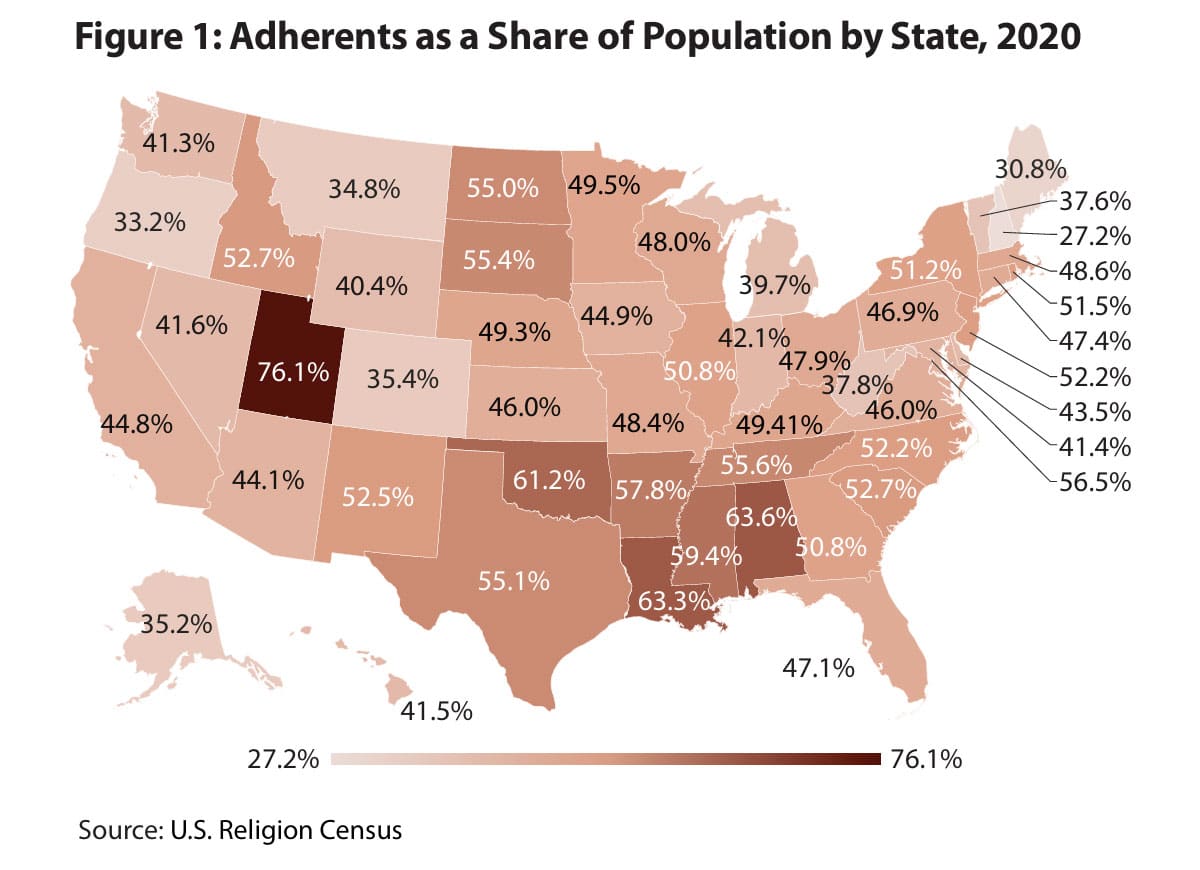Utah Is America's Most Religious State
Author: Mark WadeIf you live in Utah, or have spent much time here, then you know that a large percentage of the people of Utah are strong supporters of America's inherent belief in the Freedom Of Religion. Indeed, the Utah territory was settled by pioneers who were seeking a place where they could freely practice their religion. It may be no-small-wonder then that Utah is now home to members of at least 20 different religious organizations or groups. Perhaps this devotion to religious principles of honesty, obedience to law, and other fundamentals is part of the reason that Utah is rated as one of America's Best Places for Business, and also one of the best places to live.

Utah Ranks Highest
A recent report has identified, statistically, that Utah leads the nation in religious adherents, with 76.1% of its population identifying as members of a religion. This percentage is over 12 points higher than that of the next highest state, Alabama. In contrast, religious adherents make up 48.6% of the population across the United States. These statistics come from the University of Utah's Kem C. Gardner Policy Institute which compares religion data gathered in 2010 versus similar data gathered in 2020.

Religious Diversity
Utah is home to a very diverse and significant number of religious groups or denominations. There are at least 20 religious groups or denominations shown from largest to smallest in the following list and in the associated graphics, as published in the Gardner Policy Institute report. The table below lists the following religious organizations (churches) in order of size within the State of Utah; Church of Jesus Christ of Latter-day Saints, Catholic Church, Non-denominational Christian Churches, Muslims, Jehovah’s Witnesses, Assemblies of God - General Council, Southern Baptist Convention, Buddhism - Mahayana, Episcopal Church, United Methodist Church, Greek Orthodox Archdiocese of America, Buddhism - Theravada, Seventh-day Adventist Church, Presbyterian Church (U.S.A.), Hindu - Traditional Temples, National Baptist Convention, Hindu Yoga and Meditation, American Baptist Churches in the U.S.A., Evangelical Lutheran Church in America, Lutheran Church (Missouri Synod).

Population By County - In Utah
The state of Utah is comprised of 29 different counties, each with its own unique population dynamics. The seven most populated counties in Utah are:
Salt Lake County - The most populous county in Utah, home to the state capital, Salt Lake City. It is the cultural, economic, and political hub of the state.
Utah County - Located south of Salt Lake County, this area includes the city of Provo and is known for its rapid population growth and Brigham Young University.
Davis County - North of Salt Lake County, Davis County is part of the Greater Salt Lake City metropolitan area and includes cities like Layton and Bountiful.
Weber County - Located north of Davis County, Weber County includes the city of Ogden and is a significant industrial and logistics center.
Washington County - Situated in the southwestern part of the state, this county includes St. George and is known for its warm climate and proximity to Zion National Park.
Cache County - Found in northern Utah, Cache County includes the city of Logan and is home to Utah State University.
Tooele County - West of Salt Lake City, this county has experienced significant population growth in recent years, driven by its proximity to the capital.
In contrast, two of the least populated counties in Utah are:
Daggett County - The least populated county in Utah, located in the northeastern corner of the state. It is known for Flaming Gorge National Recreation Area.
Piute County - Situated in south-central Utah, this county is largely rural with a sparse population and is known for its outdoor recreation opportunities.
Religion By County - In Utah

The Roots Of Religion In Utah
In the mid-19th century, members of The Church of Jesus Christ of Latter-day Saints (LDS Church) migrated to Utah seeking religious freedom and sanctuary from persecution. In 1847 Brigham Young became the church's leader and led the Saints on a westward trek to settle in the Valley of The Great Salt Lake. Young and the first group of pioneers arrived in the Salt Lake Valley, which was then part of Mexico but later became U.S. territory. The harsh and isolated environment of the Utah Territory provided members of the Church of Jesus Christ of Latter Day Saints, nicknamed by some as Mormons, with a place where they could practice their religion with less outside interference. The pioneers established thriving communities throughout the western United States, partially through their cooperative efforts, and desert irrigation practices for farming. Utah has become the hub of the Church of Jesus Christ Of Latter Day Saints, with Salt Lake City as its headquarters. The church's influence grew as more members settled in the area, building communities and establishing institutions like Brigham Young University. The LDS Church's emphasis on missionary work and community cohesion further solidified its strength in Utah. Today, the LDS Church remains the predominant religion in Utah, with its values and culture deeply embedded in the state's identity. The church's significant role in Utah's history, combined with ongoing missionary efforts and a strong sense of community among its members, has ensured its continued prominence in the region.

The Catholic Church was one of the first other religions to establish a strong presence in Utah. As mining became an industry in many areas of the Utah Territory it brought many miners who were adherents to the Catholic faith and, in some communities, Catholicism was the dominant faith. As the population of Utah began to grow, so also came the growth of other religions as noted above. Learn more about Utah religious history. Learn more about Utah Religion.
Select here to view the full report on Religion in Utah.
Related Posts
July 18, 2024
June 21, 2024
June 11, 2024
June 11, 2024
